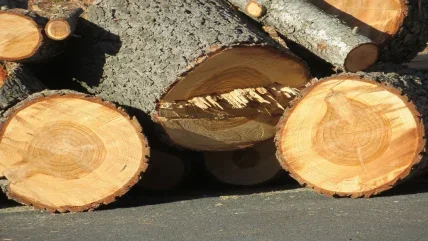
A mixed-discipline student team featuring built environment students from across the UK took top spot in the Timber Development UK (TDUK) University Design Challenge 2023 (#TDChallenge23), as they competed to reimagine and retrofit a real-life building using timber.
TDChallenge is the pre-eminent competition for students to learn how to design and build with timber, a sustainable, low-carbon building material, while providing skills they can take into their careers by simulating real challenges the students will face.
Fiercely competitive, from the 150+ who first registered, 34 students from 22 universities were selected from across the UK for the competition’s finals at NMITE’s Centre for Advanced Timber Technology to face a judging panel comprised of professional, academic and industry experts.
The mixed-discipline student teams came together and worked online for five months to produce their entries. They were given the task of reimagining Widemarsh Cricket Pavilion in Hereford, a timber-framed pavilion currently only used for storage.
The local community wanted a multifunctional space that is welcoming, warm, easy to maintain, produces more energy than it consumes and costs little to run. Teams had to retrofit and extend the building, and the triangle of ground bordered by roads and paths.
The winners – who named their team ‘Hemphasise’ – proposed to transform Widemarsh Pavilion into a flexible learning facility and community hub, which would offer opportunities for skills development, enhanced social mobility, and community cohesion.
The winning design adopted a wholebuilding approach to meet the EnerPhit retrofit standard.
“We aim for a better than net-zero carbon footprint by integrating low embodied carbon materials with efficient energy systems such as PV, storage and optimised controls,” explained the team.
Its proposed building fabric provides a medium-weight construction with thermal mass to store heat. Many of the materials are hygroscopic (breathable) and thus able to support the management of moisture.
The design uses prefabricated panels, with a mix of hemplime and wood fibre insulation within a timber frame, primarily constructed offsite. This allows local residents to take part in the assembly of some wall panels.
Shweta Salvankar, Cardiff University, reflecting on their success, said they “enjoyed the teamwork and creativity… each member brought in their strengths and we performed amazing because of it”, a sentiment echoed by all the students.
More than the win, Daniel Green, London Metropolitan University thought that the knowledge of timber was invaluable, with the challenge helping him to learn “on the flexibility of timber products – structural, insulation, and finishes”.
Dafyn Richards, Plymouth University, said they were leaving the challenge with “a much broader knowledge of timber and its possible applications and that if detailed correctly then fire and water aren’t concerns that should see it dismissed as a potential building material”.
It wasn’t just about timber that students learnt, however, with Irene Dumitrascu- Podogrocki of Newcastle University highlighting “learning the languages of other disciplines,” while Martin Juricek of Heriot-Watt University, said it was “a rare opportunity to learn about retrofit”.
Mr Juricek said the challenge meant he had to “extend my understanding of existing timber buildings and real life applications,” as they faced realistic constraints which meant the team had to be really creative with its solution.
Low carbon architect, Passivhaus designer and Green Register co-director Julia Bennett summed-up the judges’ thoughts on the winning team: “An excellent presentation, a good use of form factor analysis at concept, with consideration of circular construction challenges and opportunities,” she said. “This would be a buildable scheme with a good balance of existing and extended elements.”
“To have any hope of addressing the climate crisis, our future professionals need to know how to build and retrofit using the lowest carbon structural material – timber,” said Tabitha Binding, head of education and engagement at TDUK.
The TDChallenge is unique, offering students the opportunity to get beyond their course work and apply their learnings in a pragmatic way by working together as professionals do, and on a real world project.
“Timber is often not taught sufficiently at UK universities, so this challenge has become an important way for the industry to ‘plug the gaps’, and ensure that incoming professionals have the skills they need to thrive and build – or retrofit – the sustainable, low-carbon buildings we need today,” said Ms Binding. “Specifying the right products and detailing for longevity and reuse is essential.”
“It is a delight to see so many students and graduates from the length and breadth of the UK coming together to develop and apply their skills and passions to the challenge of making the built environment more sustainable,” added Beverly Gibbs, chief academic officer of NMITE.
“It has been a pleasure to host the TDUK University Design Challenge 23’s final day at NMITE in Hereford, and to see the creative and rigorous thought processes behind the proposed designs.”
The challenge is brought together by TDUK in a collaborative partnership with AECB, BE-ST, NMITE, Edinburgh Napier University and Passivhaus Trust, with software from Trimble, the Passive House Institute and AECB PHribbon.





